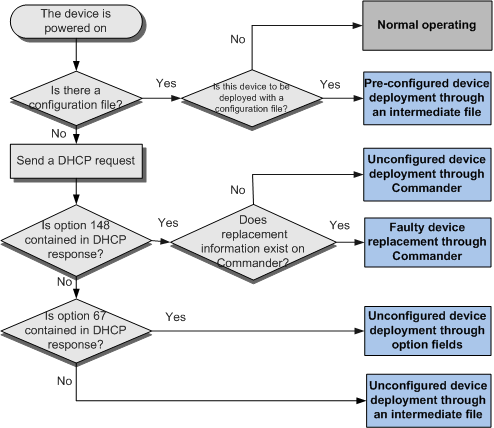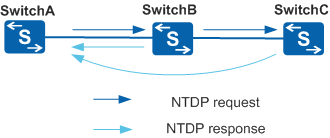Basic Concepts of EasyDeploy
The following concepts are important to understand before using EasyDeploy.
Commander
The Commander is a device that manages all other devices on a network. It communicates with clients using User Datagram Protocol (UDP) unicast packets, with the default port number 60000.
The Commander provides the following functions:
- Saves client deployment information in a database.
- Delivers the file server IP address, user name, password, and names of system software packages, configuration files, license files, patch files, web page files, and user-defined files to clients.
- Manages all clients. The network administrator configures and queries device deployment information on the Commander.
Client
A client is a device managed by the Commander. Clients obtain information about required files from the Commander, download the files from the specified file server, and then activate the downloaded files in the configured mode.

Unless otherwise specified, clients mentioned in this document refer to devices to be configured using the Commander.
Group
A group is a series of clients that need to download the same files. Defining groups for clients further simplifies configuration. You can configure various groups on the Commander according to network device deployment.
- Built-in group
Clients are grouped based on predefined device types on the Commander. Clients of the same type load the same system software package, patch file, web file, and other files.
- Customized group
The clients are grouped based on MAC addresses, ESNs, IP addresses, types, and models. You can group the clients according to network requirements. Device types used in customized groups are not predefined on the Commander.
File Server
A file server is an SFTP, FTP, or TFTP server that saves the files to be loaded to devices, including system software packages, configuration files, license files, patch files, and web page files.

A file server must have sufficient space to save files. Before configuring an S series switch as a file server, ensure that its storage space is sufficient for the files.
DHCP Server
A DHCP server allocates IP addresses to devices to be configured in zero touch device deployment, pre-configured device deployment, and faulty device replacement scenarios. After a new device is powered on, it starts the corresponding EasyDeploy process depending on whether it has a configuration file and whether the DHCP server returns the related option fields. Figure 1 illustrates the EasyDeploy decision process.
Intermediate File
An intermediate file is saved on a file server to specify information about files to be downloaded. Each line in an intermediate file specifies the MAC address or ESN of a device and files for the device. Devices to be configured can obtain information about files to be downloaded from the intermediate file and implement automatic configuration.
On the S series switches, the intermediate file name is configurable, and the file name extension is .cfg.
To configure multiple devices, define the configuration information for a device in each line in the intermediate file.
mac=0018-82C5-AA89;vrpfile=easy_V200R019C10.cc;vrpver=V200R019C10SPC100;patchfile=easy_V200R019C10.pat;cfgfile=easy_V200R019C10.cfg;webfile=easy.web.7z;
NDP
The Neighbor Discovery Protocol (NDP) is a Huawei proprietary protocol used to collect information about neighboring devices, such as the interfaces connected to the neighboring devices and system software versions of the neighboring devices.
NDP packets are encapsulated in Ethernet-II frames and periodically transmitted with a multicast destination MAC address. A device creates and maintains an NDP table based on received NDP packets. Figure 2 shows the NDP frame format.
An NDP frame contains the following fields:
- DA: destination MAC address, a fixed multicast MAC address 0x0180-C200-000A
- SA: source MAC address, the MAC address of the sender
- Type: packet type, 0x88a7 in NDP frames
- NDP: NDP data unit, body of an NDP frame
- FCS: frame check sequence.
The NDP protocol defines two timers for maintaining the NDP table on a device:
- Update timer: When this timer expires, the device immediately sends an Update packet.
- Aging timer: If the device does not receive any NDP packet from a neighbor before this timer expires, the device deletes the NDP entry matching the neighbor.
NTDP
The Network Topology Discovery Protocol (NTDP) is a Huawei proprietary protocol used to collect topology information within the configured scope on a network. The collected topology includes NDP entries.
NTDP packets are encapsulated in Ethernet-II frames. NTDP requests are periodically sent with a multicast destination MAC address, and NTDP responses are sent with a unicast destination MAC address. Figure 3 shows the NTDP frame format.
An NTDP frame contains the following fields:
- DA: destination MAC address, a fixed multicast MAC address 0x0180-C200-000A
- SA: source MAC address, the MAC address of the sender
- Type: packet type, 0x88a7 in NDP frames
- NTDP: NTDP data unit, body of an NTDP frame
- FCS: frame check sequence.
Figure 4 shows an example of a network using NTDP to collect topology information. SwitchA sends an NTDP request packet to collect topology information. After SwitchB receives the NTDP request packet, it immediately sends a response packet to SwitchA and forwards the request packet to SwitchC. SwitchC then performs the same operations as SwitchB. This process proceeds until all the devices on the network receive the NTDP request packet and send response packets to SwitchA. In this way, SwitchA obtains NDP entries and connection information of all devices and figures out the network topology based on the obtained information.
Network Topology Collection
The network topology collection function is provided by the Commander using the Neighbor Discovery Protocol (NDP) and Network Topology Discovery Protocol (NTDP). When this function is enabled on the Commander to deploy zero touch devices, users do not need to manually collect such information as device's MAC address or ESN. After zero touch devices are powered on and started, the Commander automatically collects device information and assigns client IDs to devices to bind device information with devices. The Commander can collect network topology information and specify information of files to be downloaded based on the collected network topology information. The Commander can also automatically replace faulty devices based on network topology information.



